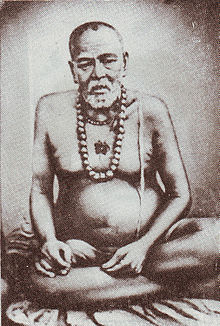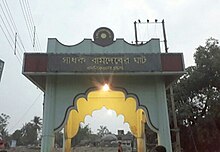Bamakhepa
This article needs additional citations for verification. (December 2015) |
Bamakhepa | |
|---|---|
 Bamakhepa | |
| Personal | |
| Born | Bamacharan Chattopadhyay 22 February 1838 |
| Died | 18 July 1911 (aged 73) |
| Religion | Hinduism |
| Nationality | Indian |
| Temple | Tarapith |
| Philosophy | |
| Religious career | |
| Guru | Swami Kailashpati |
Disciples | |
Bamakhyapa (Bengali: বামাখ্যাপা, romanized: Bamakhæpa, lit. 'mad saint'; 1837–1911[1]), born Bamacharan Chattopadhyay, was an Indian Hindu saint who is held in great reverence in Tarapith and whose shrine is also located in the vicinity of the Tara temple in Birbhum. He worshipped Maa Tara as if she was his own mother. He was born at Atla village in Rampurhat subdivision of Birbhum district.[2]

Worship[]
Bamakhaypa, goddess Tara's ardent devotee lived near the temple and meditated in the cremation grounds.[1] He was a contemporary of another famous Bengali saint Ramakrishna. At a young age, he left his house and came under the tutelage of a saint named Swami Makshadananda, who lived in a village name Dakshingram, in Birbhum district. Later he relocated to maluti, an old temple village on the banks of Dwarka River. He stayed in Mouliksha temple for continuing the worship of Holy Mother.

He perfected yoga and Tantric sadhana (worship)under the tutelage of his guru baba Kailashpati, which resulted in his becoming the spiritual head of Tarapith. People came to him seeking blessings or cures for their illness, in distress or just to meet him. He did not follow the set rules of the temple and as result was even once roughed up by the temple priests for taking food meant as offering for the deity. It is said: Ma Tara appeared in the dream of Maharani ("Queen") of Natore- Rani Bhabani and told her to feed the saint first as he was her son. After this incident, Bamakhaypa was fed first in the temple before the deity and nobody obstructed him.[3] It is believed that Ma Tara gave a vision to Bamakhaypa in the cremation grounds in her ferocious form and then took him to her breast.[1] He is also considered one of the main spiritual figures of Bengal Renaissance for his unbound devotion for Ma Tara.
Popular culture[]
Beginning in 2007, a teleserial named 'Sadhak Bamakhepa' about Bamakhepa ran on television in Bengal. By late 2011, it had run for 1500 episodes.[4]
Notes[]
- ^ a b c Kinsely, p. 111
- ^ Harding, Elizabeth U. (September 1993). Kali: The Black Goddess of Dakshineswar. ISBN 9780892546008.
- ^ Harding, Elizabeth U. (1998). Kali: the black goddess of Dakshineswar. Motilal Banarsidass Publ. pp. 275–279. ISBN 81-208-1450-9. Retrieved 26 June 2010.
- ^ Gomolo news desk. (29 Nov 2011). "Sadhok Bamakhyapa becomes highly popular" (accessed 31 Jan 2013)
References[]
- Dalrymple, William (2009). Nine Lives. The Lady Twilight. Bloomsbury Publishing Plc. pp. 203–233. ISBN 978-1-4088-0153-6. Retrieved 19 June 2010.
- Kinsley, David R. (1997). Tantric visions of the divine feminine: the ten mahāvidyās. University of California Press. ISBN 978-0-520-20499-7.
- Ramos, I. (2017). Pilgrimage and Politics in Colonial Bengal: The Myth of the Goddess Sati (1st ed.). Routledge. https://doi.org/10.4324/9781315223148
- 1877 births
- 1911 deaths
- 19th-century Hindu religious leaders
- 19th-century Bengalis
- 20th-century Bengalis
- Indian Hindu yogis
- Indian Hindu monks
- Tantra
- Bengali Hindu saints
- Hindu biography stubs